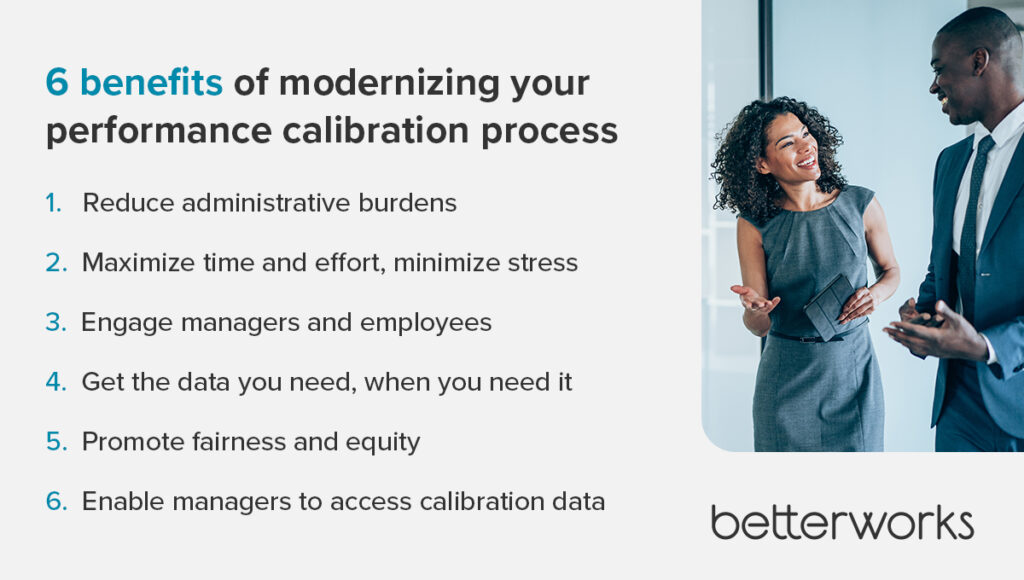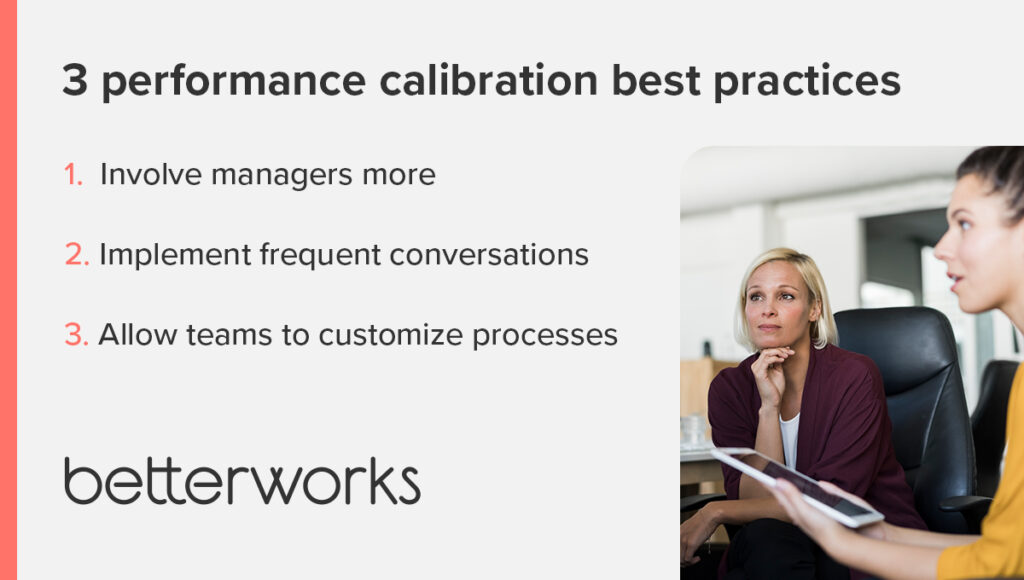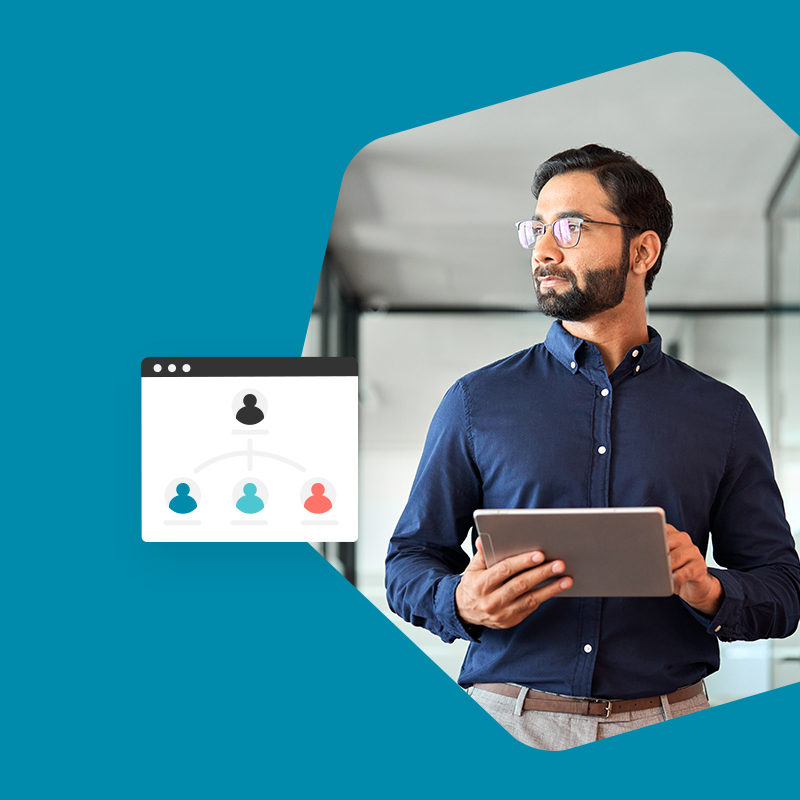- Performance calibration basics
- How does modern performance management calibration affect team performance?
- 6 benefits of modernizing your performance calibration process
- 4 common calibration challenges and how to address them
- 3 performance calibration best practices
- Apply technology to streamline calibration
Traditional performance calibration processes are anything but efficient: They’re multilayered, laborious, and drawn out. By the time most organizations complete calibration processes, the performance data is outdated and irrelevant because it is backward-looking.
Capturing the breadth and depth of workforce performance for unbiased calibration might feel like an impossible challenge. But there’s a better way to calibrate performance reviews. Shifting to a lightweight, ongoing calibration model makes the process easier for key stakeholders, saves time, and produces the data you need in a timely manner.
Discover how upgrading your performance calibration process can drive strategic value in your organization.
Performance calibration basics
Calibration refers to the process of evaluating and aligning performance ratings (or scores) across individuals or teams. The goal is to ensure fairness and consistency in performance assessment.
During the calibration process, HR leaders gather performance information for each person or group, such as ratings, rankings, or feedback from manager evaluations. Managers analyze the data, accounting for factors such as roles, goals, and skills. They then compare their teams’ evaluations against each other to pinpoint discrepancies or irregularities.
From there, calibration committees composed of leaders and managers discuss the evaluations. They might change ratings to match overall performance trends, achieve consistent results, and ensure fairness. The unfortunate reality is that adjustments are commonly made to meet distribution caps on the percentage of employees who can receive a certain ranking due to limits on merit increases. After the committees finish their work, managers confirm the adjusted ratings and share them with the affected individuals or teams.
How does modern performance management calibration affect team performance?
The ideal purpose of calibration is to create a fair and effective baseline for assessing employee performance. However, it often entails a forced distribution to rank employees in specific categories with the goal of weeding out low performers and adhering to the organization’s compensation requirements. However, traditional methods often rely on subjective evaluations, lengthy discussions, and limited data, leading to biases and inconsistencies.
By contrast, modern approaches rely on frequency, technology, data analytics, and transparency to help managers accurately identify top performers on their teams.
“Calibration can be an excellent part of a continuous performance process that can enable real-time transparency (when done more than once a year) when it has an emphasis or focus on growth and development,” says Caitlin Collins, program strategy director at Betterworks.
A continuous approach to employee and operational performance requires frequent, lightweight discussions about employee contributions and performance. Data is a natural byproduct of these conversations. When managers can access that data in real time through a central performance management system and can automate calibration processes, they can calibrate their teams throughout the year as needed. This significantly shrinks the burden of the year-end calibration process.
A more accessible calibration process increases its strategic value. Managers have more accurate data about each employee’s performance, potential, and personal goals. This helps them — and HR — place people where they can drive the greatest impact on the business and be more responsive in real-time to the performance needs of employees. It also enables managers to put more emphasis on their employees’ development aspirations and have better visibility into who on the team is carrying a bigger workload so that adjustments can be made.
“Calibration can be an excellent part of a continuous performance process that can enable real-time transparency (when done more than once a year) when it has an emphasis or focus on growth and development.”
caitlin collins, program strategy director, betterworks
6 benefits of modernizing your performance calibration process
Modernized performance calibration processes are strategic value drivers for HR. Learn about some of the other benefits.
Reduce administrative burdens
Traditional calibration processes are repetitive and time-consuming for HR, managers, and other stakeholders, reducing their availability and resources for higher-value strategic activities. This can be especially challenging for lean HR teams.
Manual calibration processes place additional burdens on HR, starting with making sure managers enter performance review data. HR must then consolidate the data into a single source they can share with managers. Additionally, performance calibration meetings require HR’s presence to record changes in performance criteria. Calibration sessions also have to be completed sequentially so that one group’s calibration is completed before another session with the next level manager can begin — making for a laborious and time-consuming process. HR must also audit the results to guarantee fair and objective performance appraisal ratings.
An automated approach, especially one based on frequent manager-employee check-ins, streamlines these processes by collecting and updating data in a repository. Everything lives in one place, reducing the likelihood of introducing errors during data replication. “There’s an ease of administering it, being able to push nine boxes out to leaders, have them calibrate, and have it roll up,” says Rob Budzinski, vice president of professional services at Betterworks. “It’s a lot more effective, efficient, and secure than a spreadsheet.”
Additionally, giving HR the ability to create and launch sessions quickly, multiple times throughout the year really makes your performance data more accurate and up to date. The ability to drive these processes frequently is in one part due to the standardized data already available in your performance platform.
Modern calibration also simplifies compliance by creating an audit trail. Transparent processes allow your team to filter employee ratings based on attributes so you see whether decisions are unfairly affecting certain employee populations.
Maximize time and effort, minimize stress
Calibration is time-consuming for many organizations because of the manual effort required, including slide decks and spreadsheets. After gathering performance data, for example, HR might create pivot tables to slice and dice the data — all before pushing out the results to managers for validation.
HR teams repeat this process at multiple levels, resulting in dozens of additional reviews. Once a manager at a certain level has completed their calibration, their manager must calibrate by reentering that same data to calibrate up the chain. And for an extra layer of impracticality, someone has to track every decision to maintain compliance records, resulting in countless hours spent on communication and bureaucracy. All of this usually keeps companies from performing calibrations more than once a year and makes the annual process a teeth-grinding exercise
By contrast, a lightweight and automated calibration process can save massive amounts of time for managers and HR — and be used on an ongoing basis. Making performance conversations lighter and more frequent simplifies these calibration processes and reduces the burden on your people by creating a rich storehouse of data that mirrors work and progress.
Think about it this way: A manager checks in with each team member once a week, maybe just for a few minutes. During the check-in, the manager creates a snapshot of their employee’s performance versus their progress, and identifies top, middle, and low performers in real time. Managers and employees have a good sense of how things are going, with less recency bias.
On an annual basis, this weekly update is a much lighter lift compared to a once-or twice-a-year review. This is because annual reviews require extensive preparation by managers, who must sift through months of data — and try to remember long-ago positives and negatives. Meanwhile, the review itself can be lengthy, as managers and employees aren’t used to communicating in a one-on-one setting about performance.
Frequent calibration is difficult, if not impossible, with annual reviews. However, when managers frequently review performance, HR can calibrate performance ratings more often. You can quickly prompt managers to consider whether they’re introducing bias or being too lenient (reporting that everyone exceeds expectations, for example).
Engage managers and employees
Managers are the stakeholders closest to performance reviews, so their insights are vital to the calibration process. Traditionally, HR gathers manager input through cumbersome calibration meetings. Such legacy processes gatekeep calibration and put the onus on HR to collect and interpret manager input.
Modern calibration processes solve this problem by giving managers the tools they need to apply basic performance ratings throughout the year. This makes results more consistent and produces a comprehensive data set without all the back and forth.
Good calibration engages employees and managers. Integrating data related to employees’ personal goals gives managers a better perspective when placing employees in a 9-box grid or other model. Tying career goals to calibration “brings the employee into it more, which is important,” says Nicolette Schumacher, program architect at Betterworks. “Why are we saying someone’s ‘high potential’ or a future leader when we don’t even know if they want to be a future leader?”
When you account for what employees want, you can use calibration data to make better decisions.
Get the data you need, when you need it
Traditional calibration efforts are so labor-intensive that most organizations are stuck with a one-size-fits-all model, such as the traditional 9-box approach. However, a more flexible and frequent calibration approach lets organizations compare people across many dimensions, including performance, potential, promotion, and leadership potential.
A more flexible calibration model empowers HR teams to calibrate specific roles, teams, and departments throughout the year. Homing in on groups helps managers and HR make targeted interventions rather than trying to address all problems at once — often belatedly. Frequent calibration helps employees see where they stand in real-time in terms of performance and potential, and it helps employers quickly identify and reward high performers.
Promote fairness and equity
Innovating your calibration process also increases the accuracy of employee performance evaluations and reduces the effect of bias in performance reviews.
Calibrating performance data paints a better picture of what’s really going on with your workforce, leaving less room for people to make assumptions. The more data you have, the better you can address factors influencing performance and weed out potential biases.
Enable managers to access calibration data
When managers can access calibration data, they’re better able to deduce their priorities, make evidence-based decisions, and align their teams’ goals with organizational objectives. Resource allocation is more straightforward, as is identifying high-performing and high-potential individuals.
Similarly, this data can help managers identify where their people need additional training or support. At the team level, data-enabled managers can easily identify common strengths or weaknesses, along with targeted strategies to improve team performance.

4 common calibration challenges and how to address them
When you understand the challenges facing your calibration process, you’re a step closer to solving them. Here are four common challenges to monitor.
Legacy processes
Calibration and performance reviews are often tied to legacy performance management practices. Updating one part of the process (such as calibration) can be difficult without reworking the entire approach. Look for opportunities within your existing process to make small changes that drive big impact.
Examine past calibrations. How has that data been used? Has it contributed to business outcomes? If calibration hasn’t historically benefited the business, then putting managers through the traditional process will do little but risk burnout and disengagement.
Modern calibration should be business-oriented. It should produce data you can use to identify current workforce performance, make strategic talent management decisions, and identify risks. “It’s a paradigm shift,” Caitlin says. “It’s not hard but can be complex, because it changes all the downstream processes, too, a little bit.”
You don’t have to start with transformative changes, Caitlin says. “They can be small tweaks. None of this has to be complicated,” she continues. “You just have to make sure that you’re thorough in your planning and your thinking.”
One example of a small change is collecting performance data throughout the year instead of concentrating on annual or twice-yearly reviews. With this simple process change, you’ll collect more data points and enrich the calibration process. When enabled by the right software, you can produce an outsized impact on calibration results.
Insufficient data or poor data
When calibration isn’t effective, bad data is the most likely cause. “Calibration can only be as good as the data you have to calibrate people on,” Caitlin says. “If you’ve got problems with your year-end review, you’re not going to have a good calibration process.”
Two common causes of poor calibration are relying on people data that’s subject to recency bias or simply not collecting enough data. Another cause is technology-related: When organizations rely on in-house document management systems for calibration, they can wind up with disconnected data that misses key aspects of performance.
As noted above, switching to frequent check-ins produces more data to work with. With data that’s strong and regularly collected, it’s easier to produce calibration results throughout the year.
Lack of purpose
Without clear goals for your calibration process, engaging managers in calibration sessions can be challenging. If managers don’t understand the purpose, they’ll struggle to understand what they should do or how to do it.
“They’re usually calibrating to look forward or to look back. If they’re looking forward, they’re trying to plan for high potentials, future leaders, and succession planning,” Nicolette says. “If they’re looking back, it’s to answer other questions: ‘Do we have the right people in the right roles? Are we managing and developing people effectively? Are there trends that we’re not seeing?’”
Connect your process to clear goals, such as identifying high-potential employees or tracking employee performance trends.
Data insecurity
Emailing spreadsheets around the company is a security risk, says Rob. When calibration is conducted within a dedicated system like Betterworks, as opposed to traditional tools such as spreadsheets or PowerPoint, the security of the process is significantly enhanced.
A centralized and secure platform where data is encrypted and access is controlled ensures confidentiality and integrity. Additionally, the structured nature of a calibration solution like Betterworks allows for standardized calibration practices, reducing the risk of bias and inconsistencies that may arise in manual processes using spreadsheets or presentations. Real-time tracking and audit trail features further contribute to transparency, compliance, and overall confidence in the performance review calibration process. This makes for a secure and reliable solution for organizations committed to fair and data-driven employee assessments.

3 performance calibration best practices
Redesign your calibration process with intention. Here are three performance calibration best practices for generating results that drive strategic value.
Involve managers more
Managers should play a central role in the calibration process. Give them the performance calibration data they need to identify high-performing individuals, allocate resources, and identify growth opportunities. Another way to help managers is by integrating data related to employees’ personal goals and career aspirations. This provides additional perspective when placing employees in performance models.
Implement frequent conversations
Frequent conversations between managers and employees lead to better quantitative and qualitative data over time. This gives your calibration process high-quality data that better reflects employee performance. Meanwhile, workers see where they stand in real time rather than having to wait for an annual review or calibration discussion.
While these conversations occur more often, they’re collectively more streamlined and less laborious than conducting performance reviews once or twice a year. More frequent check-ins translate into mid-year or end-of-year reviews that take less time because they’re based on existing accurate data.
Allow teams to customize processes
A modern, lightweight approach to calibration creates flexibility for teams and departments to tailor their calibration activities. For instance, one team may choose to combine weekly check-ins and peer feedback, while another team may prefer monthly performance reviews and manager assessments. Creating flexibility allows teams to align their calibration activities and goals. Evaluations are relevant, timely, and meaningful for their specific context while still being consistent with the organization as a whole.

Apply technology to streamline calibration
When HR leaders and managers implement automated performance calibration tools, they streamline the entire process, minimize paperwork, and reduce administrative burdens. Technology enables real-time data collection, analysis, and reporting, providing invaluable insights for making informed decisions, identifying performance trends, and allocating resources.
Most importantly, technology empowers managers to take a direct role in calibration. Betterworks provides manager-access calibration, a feature that empowers managers to participate in the process in real time while automatically tracking changes. Managers can share, view, and edit calibration information.
“The performance snapshot, the data — everything about the employee can be looked up and quickly help managers make decisions and put the right people where they need to be,” Rob says. This saves time and makes evaluations more accurate and fair. The ultimate result? Better calibrations, more successful organizations, and a culture of continuous improvement.
Want to learn more? Discover the benefits of Betterworks Calibration.
There’s a way better way to do calibration





